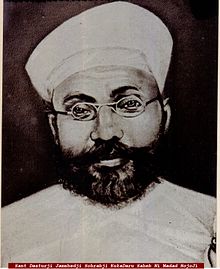- Dastur Jamshed Ervad Sohrab Kukadaru
-
Dastur Jamshed Ervad Sohrab Kukadaru Saheb was a pious Parsi Zoroastrian priest of Mumbai, India. He was born on 26 May 1831 in Surat, Gujarat, India. The day as per the Zoroastrian calendar was Yazdegerdi Mah (month) Ava, Roj (day) Zamyad. The Indian Gujarati term ‘Saheb’ (respected sir) is added to his name as a mark of respect. He is revered among the Zoroastrian Parsi community in India and overseas and is considered to be a saint by many in the community. His life was filled with miraculous events which have been documented extensively in Gujarati as well as English. Dasturji Saheb died on 4 January, 1900 on the Yazdegerdi calendar day Behram in the month of Fravardin. [1]
Contents
Life of Dasturji Kukadaru
When Dasturji Kukadaru Saheb moved from Surat to the larger city of Mumbai, he became a Panthaki (priest) of Kapawala Agiary (Fire-Temple) at Nizam Street, Baharkot. Dasturji Kukadaru Saheb lived a simple life. He used to wash his own clothes and ate only one meal a day which consisted of rice and ghee (clarified butter). He used to cook it by keeping a vessel of rice in the rays of the sun and reciting the sacred Avestan verses. He did not eat meat, and only consumed milk and fruits. Dasturji Kukadaru Saheb made a number of predictions that came true, such as the passing away of Empress Victoria of England and other personalities in India at that time. [2]
The Gold Bar Miracle
Several miracles were performed by Dasturji Kukadaru Saheb, and the most famous one was the Gold Bar miracle. Dasturji Saheb transformed an ordinary brick into a large bar of gold by praying the ancient Avestan prayers throughout the night. This was on request of the Zoroastrian devotees to cover a shortfall in the construction money for the Anjuman Atash Behram building at Dhobi Talao (Mumbai, India). The sum of Rupees 10,000 was raised by selling the transformed bar of gold, a very large amount of money in those days (19th century). Even today, an amazing life-like portrait of Dasturji Kukadaru Saheb is placed in the hall of the Atash Behram, and similar portraits of Dasturji Kukadaru Saheb are placed in most of the Parsi Zoroastrian Atash Behrams and Agiaris (Fire Temples) in the Indian subcontinent. Dasturji Kukadaru Saheb also cured people of diseases by praying the Avestan scriptures of the Zoroastrian religion. [3]
Fame in the 20th Century
Dasturji Kukadaru Saheb during his lifetime was not a Dastur (High Priest) but an Ervad, a medium-level category of Zoroastrian priesthood. After he died, at the Uthamna (Zoroastrian prayers for the departed) ceremony, Dasturji JamaspAsa declared that his name should henceforth not be recited as ‘Ervad Jamshed Ervad Sohrab’ but as ‘Dastur Jamshed Ervad Sohrab’ as a mark of unprecedented respect. Many years after Dasturji Kukadaru Saheb had died, Ervad Nadarsha Navroji Aibara who was a well-known priest of Cusrow Baug, Colaba, (Mumbai, India) was responsible for rekindling the faith in Dasturji Kukadaru Saheb among the Parsi Zoroastrian community in India and overseas. Ervad Nadarsha Navroji Aibara was born in 1933, which was a number of years after Dasturji Kukadaru Saheb had left the physical world. Ervad Aibara’s spiritual Guru (mentor) was Dasturji Kukadaru Saheb, and Dasturji Kukadaru Saheb’s spiritual Guru was the more ancient Dastur Azar Kaiwan Bin Azar Gushasp Saheb. [4]
Nirang Prayers to help people
Ervad Aibara mentioned that over the years, the spiritual power of Dasturji Kukadaru Saheb communicated with him regularly through his inner voice. Dasturji Kukadaru Saheb gave Ervad Aibara a number of nirangs (short prayers) and instructed him to give these nirangs to any person who came to him for help in difficulties. Many people benefited from these prayers in India as well as overseas, during the later half of the 20th century. The faith in Dasturji Kukadaru Saheb spread considerably due to the power of these prayers. [5]
External links
- Article on Dasturji Kukadaru Saheb
- Kukadari, Jamshedji Sorab article on Encyclopaedia Iranica Online
- Dr. (Mrs.) Hilla Minoo Wadia's Stories of Dasturji Kukadaru Saheb
- Traditional Zoroastrianism Web Site
References
- ^ Michael Stausberg and Ramiyar P. Karanjia, “Kukadaru, Jamshedji Sorab,” Encyclopaedia Iranica Online, June 23, 2008, available at www.iranicaonline.org.
- ^ Ervad Burjor H. Antia, Zarthoshti Anjuman Atash Bahram A Book celebrating the 100 years of its enshrinement, Anjuman Atash Bahram
- ^ Ervad Burjor H. Antia, Zarthoshti Anjuman Atash Bahram A Book celebrating the 100 years of its enshrinement, Anjuman Atash Bahram
- ^ Dr. (Mrs.) Hilla Minoo Wadia (2003), Late Ervad Nadarsha Navroji Aibara Blessed by Sant Dasturji Kukadaru Saheb, Kukadaru Trust
- ^ Dr. (Mrs.) Hilla Minoo Wadia (2003), Late Ervad Nadarsha Navroji Aibara Blessed by Sant Dasturji Kukadaru Saheb, Kukadaru Trust
Categories:- Zoroastrianism
- History of Zoroastrianism
- Zoroastrian saints
Wikimedia Foundation. 2010.


